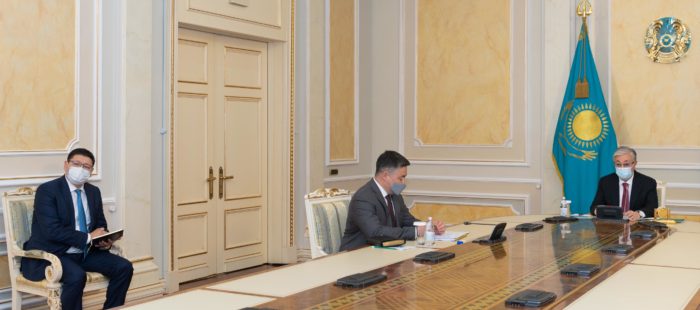NUR-SULTAN – Kazakh President Kassym-Jomart Tokayev approved the annual report of the National Bank for 2020 during a meeting with Governor of the National Bank of Kazakhstan Erbolat Dossaev on May 14, reported Akorda Press.

Kazakh President Kassym-Jomart Tokayev met with Governor of the National Bank of Kazakhstan Erbolat Dossaev on May 14. Photo credit: Akorda Press.
It was reported that the National Bank’s activities in managing the National Fund were recognized as successful. At the end of 2020, the National Fund’s investment income amounted to 7.6 percent, or $4.2 billion and stood at $940 million for four months of 2021.
Tokayev said that the National Fund fulfilled its role during the pandemic. The National Fund’s transfers increased by 55 percent and reached 4.8 trillion tenge (US$11 billion) in 2020. This was “the main task of the National Fund in the context of the global crisis.”
“This year, the transfers should be directed to post-crisis development. After the economic recovery, the budget cannot not rely on the fund’s transfers. The use of the funds from the National Fund should be reduced in the future,” said Tokayev.
According to the President, the National Bank should continue its work with the Agency for the Regulation and Development of Financial Markets to improve the efficiency of monetary policy and build up the potential of the financial sector.
Tokayev noted that the pandemic and the decline in oil prices had a negative impact on the economy last year. The anti-crisis measures prevented a decline in the national economy and supported business activity.
“The National Bank has allocated 2.3 trillion tenge (US$5.3 billion) for measures to support the economy and employment situation. Due to this, we maintained business activity and prevented mass unemployment. The National Bank’s work with the government is of special importance now,” said the President.
The National Bank performed a stimulating monetary policy to ensure macroeconomic stability, support the economy and reduce inflationary risks. As a result, inflation remained within 8-8.5 percent and stood at 7.5 percent at the end of 2020.
The bank developed a monetary policy strategy through 2030 to increase the efficiency of the current policy and transit to a full-fledged inflation targeting regime.
Dossaev said that the share of non-cash payments increased due to the introduction of a remote identification service and a decrease in the size of the interbank and commission rates.


